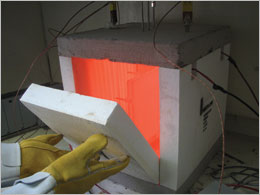Researchers at the US National Institute of Standards and Technology (NIST) have developed a technique for measuring a key thermal property of fire-resistive materials at high temperatures.
The measurement technique has already been adopted commercially and incorporated into a US standard.
In creating computer simulations to study the collapses of the World Trade Center buildings on 11 September 2001, NIST researchers needed to know important properties of the fireproofing materials that protected the structural steel columns.
One key property was the thermal conductivity of the material.
There are long-established methods for measuring thermal conductivity under ambient conditions, but a material's thermal conductivity can change markedly when it is subjected to extremely high temperatures that cause important chemical and structural changes.
Traditional methods for measuring thermal conductivity at high temperatures have not been adequate.
NIST's Dale Bentz and his colleagues Robert Zarr and Daniel Flynn developed a so-called 'slug calorimeter' technique to obtain the thermal conductivity information at elevated temperatures.
With this technique, they used a thin square slab of steel material known as a slug and sandwiched it between slabs of the fireproofing material of interest.
Guard insulation surrounds the sides of the sample so heat flows preferentially through the sandwich when it is placed in a high-temperature furnace.
Three temperature probes inserted into the steel slug measure the heat flowing to the steel.
Combining this data with the known heat capacities and densities of the steel slug and the fire-resistive material, the researchers determine the material's thermal conductivity at various temperatures.
Following the successful demonstration of the method at NIST, two large US testing labs, Intertek and Southwest Research Institute, have worked with NIST to develop their own in-house slug calorimeters as a testing service to their clients, and a third US company, Anter Corporation, recently introduced a commercial version of a slug calorimeter called the FireLine 1000.
ASTM International (formerly the American Society for Testing and Materials) has published a standard (ASTM E 2584) detailing how to conduct thermal conductivity measurements with the new method.
Possible applications beyond steel fireproofing material, Bentz said, involve measuring the thermal conductivity of wood-based materials, as well as the insulating materials used to protect spacecraft such as the space shuttle.

Thermal capacitance calorimeter (without a sample) inside a small furnace heated to 1000°C (1832°F). Thermocouples are inserted through the top insulation panel to record the temperature of the furnace, sample, and steel slug throughout the test




Swiss geoengineering start-up targets methane removal
Several rather dubious statistics in this report. IF methane had 120× the thermal effect of CO2 that would be TWO orders of magnitude. Two is not...